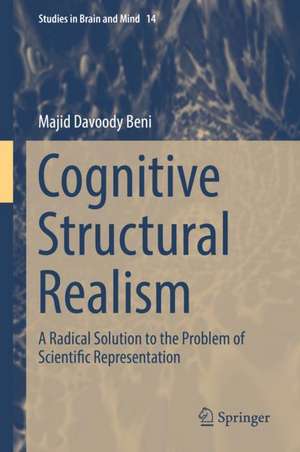Cognitive Structural Realism: A Radical Solution to the Problem of Scientific Representation: Studies in Brain and Mind, cartea 14
Autor Majid Davoody Benien Limba Engleză Hardback – 7 feb 2019
In this book, the author develops a new form of structural realism and deals with the problem of representation. The work combines two distinguished developments of the Semantic View of Theories, namely Structural Realism (SR), a flourishing theory from contemporary philosophy of science, and Ronald Giere and colleagues’
Cognitive Models of Science approach (CMSA).
Readers will see how replacing the model-theoretic structures that are at issue in SR with connectionist networks and activations patterns (which are the formal tools of computational neuroscience) helps us to deal with the problem of representation. The author suggests that cognitive structures are not only the precise formal tools for regimenting the structure of scientific theories but also the tools that the biological brain uses to capture the essential features (i.e., structures) of its environment. Therefore, replacing model-theoretic structures with cognitive structures allows us to account for the theories-reality relationship on the basis of the most reliable theories of neurology. This is how a new form of SR, called Cognitive Structural Realism (CSR) is introduced through this book, which articulates and defends CSR, and shows how two diverging branches of SVT can be reconciled.
This ground-breaking work will particularly appeal to people who work in the philosophy of science, philosophy of mind and cognitive sciences.
Din seria Studies in Brain and Mind
-
 Preț: 391.22 lei
Preț: 391.22 lei - 15%
 Preț: 645.96 lei
Preț: 645.96 lei - 15%
 Preț: 583.61 lei
Preț: 583.61 lei - 24%
 Preț: 686.51 lei
Preț: 686.51 lei - 15%
 Preț: 699.77 lei
Preț: 699.77 lei - 15%
 Preț: 707.96 lei
Preț: 707.96 lei - 15%
 Preț: 645.47 lei
Preț: 645.47 lei - 15%
 Preț: 643.99 lei
Preț: 643.99 lei - 20%
 Preț: 554.05 lei
Preț: 554.05 lei - 15%
 Preț: 578.05 lei
Preț: 578.05 lei - 18%
 Preț: 791.40 lei
Preț: 791.40 lei - 18%
 Preț: 777.03 lei
Preț: 777.03 lei - 15%
 Preț: 646.94 lei
Preț: 646.94 lei - 15%
 Preț: 691.91 lei
Preț: 691.91 lei - 15%
 Preț: 698.80 lei
Preț: 698.80 lei - 15%
 Preț: 641.85 lei
Preț: 641.85 lei - 18%
 Preț: 1118.45 lei
Preț: 1118.45 lei - 15%
 Preț: 639.25 lei
Preț: 639.25 lei - 15%
 Preț: 662.80 lei
Preț: 662.80 lei -
 Preț: 392.21 lei
Preț: 392.21 lei -
 Preț: 394.71 lei
Preț: 394.71 lei -
 Preț: 394.51 lei
Preț: 394.51 lei
Preț: 390.08 lei
Nou
Puncte Express: 585
Preț estimativ în valută:
74.65€ • 77.65$ • 61.63£
74.65€ • 77.65$ • 61.63£
Carte tipărită la comandă
Livrare economică 14-28 aprilie
Preluare comenzi: 021 569.72.76
Specificații
ISBN-13: 9783030051136
ISBN-10: 3030051137
Pagini: 331
Ilustrații: XI, 188 p. 1 illus.
Dimensiuni: 155 x 235 mm
Greutate: 0.46 kg
Ediția:1st ed. 2019
Editura: Springer International Publishing
Colecția Springer
Seria Studies in Brain and Mind
Locul publicării:Cham, Switzerland
ISBN-10: 3030051137
Pagini: 331
Ilustrații: XI, 188 p. 1 illus.
Dimensiuni: 155 x 235 mm
Greutate: 0.46 kg
Ediția:1st ed. 2019
Editura: Springer International Publishing
Colecția Springer
Seria Studies in Brain and Mind
Locul publicării:Cham, Switzerland
Cuprins
Chapter 1. Introduction.- Chapter 2. The Parting of the Ways.- Chapter 3. The Grounding Problem: Why Worry?.- Chapter 4. Churchland’s Extension of Cognitive Models of Science.- Chapter 5. The Brain’s Predictive Processing.- Chapter 6. An Ecological Solution to the Grounding Problem.- Chapter 7. Cognitive Structural Realism.- Chapter 8. Conclusion: Meeting of the Ways.
Notă biografică
Majid D. Beni obtained his PhD. at Tehran, Iranian Institute of Philosophy. He wrote greater part of his dissertation when he was visiting the School of Life Science, at ASU, where he worked on the history of philosophy of science under the supervision of Rick Creath. For the past few years he taught courses on the philosophy of science, philosophy of cognitive science, and mathematical logic. Through his career he attempted drawing connection between his work on Structural Realism and the philosophy of science on the one hand and recent developments in computational neuroscience and empirical and theoretical psychology on the other hand. He has developed Epistemic Informational Structural Realism and Structural Realist theory of Self in his previous publications.
Textul de pe ultima copertă
In this book, the author develops a new form of structural realism and deals with the problem of representation. The work combines two distinguished developments of the Semantic View of Theories, namely Structural Realism (SR), a flourishing theory from contemporary philosophy of science, and Ronald Giere and colleagues’
Cognitive Models of Science approach (CMSA).
Readers will see how replacing the model-theoretic structures that are at issue in SR with connectionist networks and activations patterns (which are the formal tools of computational neuroscience) helps us to deal with the problem of representation. The author suggests that cognitive structures are not only the precise formal tools for regimenting the structure of scientific theories but also the tools that the biological brain uses to capture the essential features (i.e., structures) of its environment. Therefore, replacing model-theoretic structures with cognitive structures allows us to account for the theories-reality relationship on the basis of the most reliable theories of neurology. This is how a new form of SR, called Cognitive Structural Realism (CSR) is introduced through this book, which articulates and defends CSR, and shows how two diverging branches of SVT can be reconciled.
This ground-breaking work will particularly appeal to people who work in the philosophy of science, philosophy of mind and cognitive sciences.
Caracteristici
Dissolves the most vicious problem of scientific realism (i.e., the problem of scientific representation) Promotes and reconstructs the cognitive models of science approach Develops a new form of structural realism Combines the philosophical and scientific resources of Structural Realism along with Ronald Giere and friend’s Cognitive Models of Science approach
